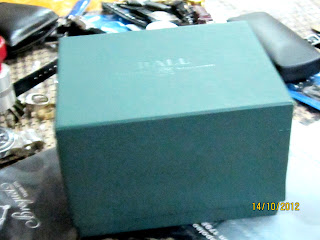AUTHENTIC SWISS MADE BALL FIREMAN STANDARD RR MEN'S WRISTWATCH
MODEL NM1083C
SHINNING WHITE DIAL WITH BLUE AND WHITE ARABIC AND BATON MARKERS, VERY BRIGHT H3 GAS LUMINOUS LASTING FOR 20 YEARS
DATE WINDOW AT 3:00
SAPPHIRE CRYSTAL IS CLEAN, NO CRACK NO SCRATCHES
SWISS BALL AUTOMATIC MOVEMENT
LUMINESCENT SILVER TONE METAL HANDS
LARGE LUMINESCENT ORANGE ARABIC MARKER AT 12:00 AND 6:00
STAINLESS STEEL CASE MEASURES APPROXIMATELY 45m EXCLUDING THE CROWN AND 45mm LUG TO LUG.
CROWNED IS PROPERLY SIGNED
BALL STAINLESS STEEL DOUBLE CLASP BAND FITS 8.5" WRIST
WATCH WORKING AND KEEPING TIME
COMPLETE WITH BOX, OUTER BOX AND PAPERS - LUXURY WATCH FOR MEN
YOUR CHANCE TO WEAR THE LUXURY BALL WATCH
PRICE/HARGA : RM3,500 (SOLD TO SALIM FROM PJ)
SOLD:RM3500
BRIEF HISTORY OF BALL WATCHES
Webster Clay Ball
(October 6, 1847 – 1922) was a jeweler and watchmaker born in
Fredericktown, Ohio. After a two-year apprenticeship to a jeweler, Ball
settled in Cleveland, Ohio to join a jewelry store. When Standard Time
was adopted in 1883, he was the first jeweler to use time signals from
the United States Naval Observatory, bringing accurate time to
Cleveland.
In
1891 there was a collision between Lake Shore and Michigan Southern
Railway trains at Kipton, Ohio, which occurred because an engineer's
watch had stopped. The railroad officials commissioned Webb C. Ball as
their Chief Time Inspector, in order to establish precision standards
and a reliable timepiece inspection system for railroad chronometers.
He
established strict guidelines for the manufacturing of sturdy,
reliable precision timepieces, including resistance to magnetism,
reliability of time keeping in 5 positions, isochrosnim , power reserv
and dial arrangement, accompanied with record keeping of the
reliability of the watch on each regular inspection.
His
original jewelry business in Cleveland grew into the Ball Watch
Company (currently headquartered in Neuchatel, Switzerland), which used
other watch companies' movements, perfecting them and then reselling
them. Ball Watch Company also ordered watches complete from other watch
companies. Ball used movements from the top American manufacturers,
Elgin, Hamilton, and Waltham, and switched to Swiss movements as early
as the 1940s in their wristwatches. The Waltham Watch Company complied
immediately with the requirements of Ball's guidelines, later followed
by Elgin National Watch Company and most of the other American
manufacturers: Aurora, Hamilton, Hampden, E.Howard & Co., Illinois,
Seth Thomas, later on joined by some Swiss watch manufacturers:Audemars
Piguet, Gallet, Longines, Record Watch, Vacheron Constatin. .
Webb
C. Ball became the vice president of the Hamilton Watch Company and
focused his efforts on developing watches for the railroads. On
February 10, 1907, the Brotherhood of Locomotive Engineers honored his
efforts by appointing Ball as an honorary member.
They
were the first wrist watch allowed to be used on the Railroads, (using
a Swiss manual wind movement) followed quickly by the first American
made wrist watch on "the roads", Elgin.
The
firm was family owned by direct descendants until the 1990s when the
right to use the name was sold. The new firm continues the tradition,
using Swiss-made (primarily ETA) movements and making watches for
sportsmen and even for some small railroads.
At
the end of his career, Webb C. Ball was overseeing over 125,000 miles
of rail tracks in the U.S.A., Mexico & Canada , having greatly
contributed to the security of all railroad systems. The Horological
Institute of America celebrated his efforts on October 20, 1921. He died
in 1922.












No comments:
Post a Comment